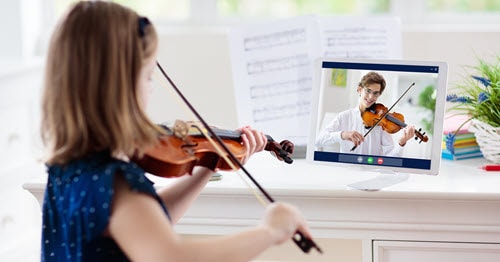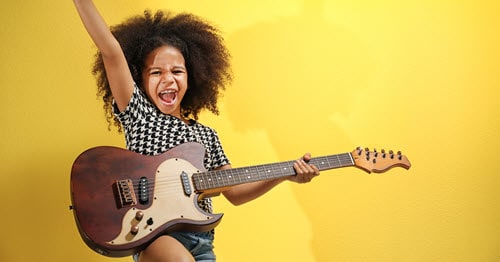6 Ways Online Students Can Socialize Outside of the Classroom
by Phoebe Brown
by Valerie Kirk
5 min to readChildren are naturally drawn to music. Ask any parent, and they can probably still sing the words to the song their child was obsessed with when they were toddlers. From “Baby Shark” to “Let It Go”, songs capture the attention of small children, calm them down, soothe them to sleep, and help them focus.
There are so many benefits to fostering a love of music in kids! A recent study found that kids who were exposed to music in early childhood had accelerated brain development, and developed better reading and communication skills. Rhythms and melodies help kids memorize phrases and grasp language patterns, leading to better language acquisition.
There are more benefits when your child chooses to play a musical instrument. That same study found that music training whether through school programs or private lessons—had a positive impact on a child’s social, emotional, and cognitive development. and cognitive development.
Music is a language that is often learned and enjoyed with other children. Melodies can elicit a range of emotions from joy and excitement to peace and reflection, giving kids the opportunity to experience— and adjust to—new feelings.
Other benefits for kids who learn to play a musical instrument include:

From drums to the harp, there are so many instruments to choose from, leaving parents wondering how to pick a musical instrument for their child to learn. There are many steps to consider when choosing a musical instrument, but perhaps the most important one is to get your child involved in the decision. Learning to play an instrument requires commitment and practice, and kids have to be engaged with learning the instrument to make that commitment. This starts with empowering them to choose a musical instrument to learn that interests them.
Here are five ways to choose the right musical instrument for your child learn:
Kids often don’t know which instruments make which sounds. By listening to different kinds of music and taking them to age-appropriate concerts and musical shows, they can start to pick up on the different instruments that work together to create a song. Help them by pointing out the different instruments. Point out the drum, guitar, or piano during solos. When you hear an orchestra, tell them that the higher notes they are hearing are coming from the violin and viola, and the lower tones are from the cello and bass. Woodwind instruments like the clarinet and saxophone make a different sound than brass instruments like the trumpet and trombone. Hearing the different sounds that different instruments make can help spark an interest in a particular instrument your child may want to learn.
Some musical instruments can be big and bulky and require more mature fine motor skills. When choosing a musical instrument for your child, keep in mind how they will hold and transport the instrument. Guitars are a wonderful first instrument to learn, but they are a bit bigger, so they may be harder to hold for a child with a smaller frame. Good first instruments for smaller hands include the piano, drums, flute, violin, and ukulele. But if your child is interested in a larger instrument, consider exploring scaled down versions that fit their hand size.
Kids who don’t have an interest in the more traditional or popular instruments like the piano or drums may be drawn to instruments that are more unique. Have you ever seen a bassoon or heard of an oboe? These are unique instruments! The bass clarinet and French horn both make wonderful sounds but aren’t often chosen by students. When thinking about how to choose a musical instrument to learn, search out the more unique instruments for your unique child to help spark an interest in learning how to play an instrument.
Music stores want your child to play an instrument! They also want to make sure that the instrument they choose is one that they will love. Most stores will let you give instruments a test run in the store so your child can hear the sounds they make. This also helps them see if they can hold the instrument properly. Music stores often have a rent-to-own program, so if you decide your child doesn’t like the instrument and would rather try something else after a few months, you can exchange it for a different one.
Your child may change their mind over time—and that’s OK! It isn’t uncommon for a child to start learning on one instrument, but as they grow and become more immersed in playing music, they may decide to try another instrument. This is especially true if your child starts learning to play an instrument in elementary school. It’s easier for smaller kids to start playing the piano or drums (usually on a drum kit), but as they grow and mature, they can move to larger instruments and those that require more lung capacity, like woodwinds or brass instruments.

Online school offers many opportunities to foster a love of music and support your child’s musical interests. Connections Academy offers online music clubs to help your child connect with other musically talented students. Online school students also have more flexibility to practice on their schedule and to participate in community musical groups and choirs.
Attend one of our virtual information sessions to learn more about how online school can help your child feed their love of music.
